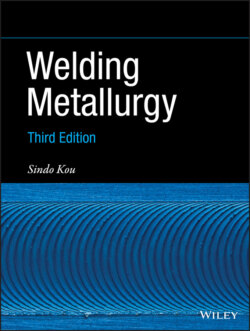Читать книгу Welding Metallurgy - Sindo Kou - Страница 96
3.4.2 Heiple's Theory for Weld Pool Convection
ОглавлениеHeiple et al. [27–31] proposed that, when a surface‐active agent is present in the liquid metal in a small but significant quantity, ∂γ/∂T can be changed from negative to positive, thus reversing the direction of Marangoni convection and making the weld pool much deeper. Heiple's theory is illustrated in Figure 3.16 [32]. Examples of surface‐active agents in steel and stainless steel are S, O, Se, and Te. Keene et al. [33] showed ∂γ/∂T of liquid stainless steel can be reversed if the S is increased to, e.g. 160 ppm (Figure 3.16a).
Figure 3.16 Effect of sulfur on surface tension and weld penetration: (a) surface tension data; (b) model of Heiple and Roper.
Source: Kou, Limmaneevitchitr, Wei [32]. Welding Journal, December 2011, © American Welding Society.
Since surface tension is a pulling force, when surface‐tension gradients exist along the weld pool surface, the liquid of higher surface tension pulls the liquid of lower surface tension toward itself. This causes the liquid on the weld pool surface to flow from the location of lower surface tension to that of higher surface tension.
Heiple's theory is explained in Figure 3.16b. In the absence of a surface‐active agent, the warmer liquid metal of lower surface tension near the center of the pool surface is pulled outward by the cooler liquid metal of higher surface tension at the pool edge. In the presence of a surface‐active agent, on the other hand, the cooler liquid metal of lower surface tension at the edge of the pool surface is pulled inward by the warmer liquid metal of higher surface tension near the center of the pool surface, where it is heated by the heat source before going axially downward to the pool bottom. This increases melting at the bottom of the pool, thus increasing the weld penetration.
Figure 3.17 shows two YAG laser welds made in 6.4‐mm‐thick 304 stainless steel plates in the conduction mode at 3000 W power and 3.39 mm/s travel speed [34]. The weld in the plate with 140 ppm S is deeper than that with 40 ppm S, consistent with Heiple's theory.
Figure 3.17 Effect of sulfur on YAG laser welds: (a) 304 stainless steel with 40 ppm sulfur; (b) 304 stainless steel with 140 ppm sulfur.
Source: Limmaneevichitr and Kou [34].
Sahoo et al. [35] and McNallan et al. [36] calculated the surface tension of liquid metals based on thermodynamics. Figure 3.18 shows the surface tension of liquid iron as a function of temperature and the sulfur content [37]. For pure Fe, ∂γ/∂T is negative at all temperatures. For sulfur‐containing Fe, however, ∂γ/∂T can be positive at lower temperatures, which is consistent with the surface tension measurements by Sundell et al. [38]. Based on the surface tension data in Figure 3.18, Pitscheneder et al. [37] calculated Marangoni convection in stationary steel weld pools. Zacharia et al. [39] showed that computer simulations based on a positive ∂γ/∂T for liquid steel at all temperatures can over predict the pool depth.
Figure 3.18 Liquid iron with various levels of sulfur: (a) surface tension; (b) temperature coefficient of surface tension.
Source: From Pitscheneder et al. [37]. Welding Journal, March 1996, © American Welding Society.
